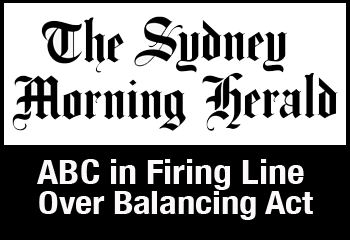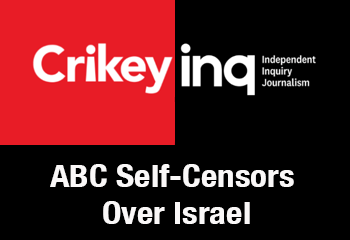Before
In April 2009, Ronin Films contacted me to inform me that Hope in a Slingshot was accepted by the ABC TV (Australia) and would be broadcast in December 2009. Contracts were to be signed in the new tax year which in Australia begins in July. By September, I had not heard from them. I was residing in Malta at the time.
In September 2009, Andrew Pike, director of Ronin Films, informed me that there was trouble, and that they were working on it. I asked about the legalities involving the renumeration and they confessed that because no contracts were signed there was little that could be done. Despite having previously signed off on the film (internally at the ABC) Kim Dalton, the head of the ABC TV at the time, was breaking all precedence and protocol and using his power to pull the film. The reasons were unclear. The acquisition editors were outraged. The Friends of the ABC became involved and produced press releases. It was written about in the Age, Sydney Morning Herald and some industry magazines. Senator Scott Ludlam took on the case against the ABC in the Senate Estimates and Dr Jake Lynch, the head of the department of Peace and Conflict Studies at the University of Sydney invited me to large international conference to screen it and talk about it. . There were independent one-off screenings in all the east coast cities plus Adelaide organised by groups supportive of unbiased media reformation and peace in the Middle East. I was invited to talk on panels.


Filmmaker’s response to all the above
After reading the above articles and PDF’s you may come away harbouring doubts on whether: 1) the ABC could find another film, (in their quest for what could reasonably be called false-balance) 2) the ABC would have screened both films (as they claimed) if they did find such a film 3) Hope in A Slingshot’s research findings were up to ABC rigorous standards.
Allow me to clear those doubts completely.
Ronin Films and I searched and found (very readily) the producers of two award winning documentaries that presented a counter-balance to Hope in a Slingshot.
“The Case for Israel: Democracy’s Outpost” is pro-war, pro-wall, pro-occupation and pro-status quo and furthermore harmoniously aligned with the framing of the nightly-news, on most main-stream channels in Australia at the time. The director, Michal Yohay was contacted via email and responded enthusiastically to the potential of having his film screened in Australia on the ABC TV.
“To See If I’m Smiling“, is a deeply nuanced film about women in the Israeli Military who served in the occupied territories. It is one of my personal favourite documentaries set in the region and it is entirely the perspective of Israeli women serving in the Israeli military made by an Israeli woman who had done the same. The director/writer Tamar Yarom was delighted at the prospect of having her film screened by the ABC TV.
The ABC never responded to our offers of these films, despite repeated attempts from us to make contact. The ABC never contacted the producers or directors of the aforementioned films. They claimed they could not find any films.
The ABC were, sadly, abjectly insincere about their reason to not film Hope in a Slingshot according to Clause 6.1 and 6.6.3, of their editorial policy at the time (as they claimed – (See letter from Kim Dalton above). These clauses asked for ‘balance’ of differing points of view.
By the time of the second Senate Estimates the ABC denigrated the credibility of the research findings presented in the film. As an activist filmmaker I am accustomed to belonging to the faction of little power and funds and I worked within the ethos that the film’s facts had to be bullet proof. Making a film that would challenge deeply held views on the nobility and credibility of the Israeli military and government would require nothing less.
Did the ABC back their claim that the film was not credible, with any evidence whatsoever?
No.
Did the ABC ask to see evidence of my research?
No
The Acquisitions team were angered by the censorship of this film. They had done their due diligence checks before accepting the film. Interestingly such a censorship had never before happened in Australian ABC TV history.
Seeing as this is my website I will share with you where I gathered my statistics from because I am proud of my diligence and hurt that the ABC chose to use their power to discredit me and invalidate my work, rather than admit any valid reason for the censorship. Most of the stats came from the United Nations Office For The CoOrdination Of Humanitarian Affairs. I also got information from the Palestinian Consensus Report; the Israeli Central Bureau of Statistics; the United Nations Relief and Works Agency and some NGOS including Friends of Humanity International; Addameer; Al-Haq; B’stelem and the Israeli Coalition Against House Demolition.
Gathering the statistics from reputable organisations, and verifying such statistics with those that other organisations gathered (if more than one organisation or individual did so) led to discrepancies being revealed. The subject matter is, after-all, a geo-political stand-off and agendas are rife. To inform and address such discrepancies, the film clearly displays, both figures, so viewers could know that this is the reality of the situation. No one really knows for example how many deaths there have been unless they count the bodies themselves, because one reputable organisation says X and the other says Y.
I recall that the number of politically released (as opposed to just released) prisoners in comparison to the number of arrests, could only be collected from Mr Fuad Al Khoffash, whose work was recommended to me by Dr Sattar Kassem of Nablus University and endorsed by the Friends of Humanity International, an international organisation based in Vienna. No Israeli organisation had such records available to an English speaking & reading journalist.
Furthermore, Hope In A Slingshot’s graphical-map-explanation of the part-history of the region was approved of by Professor Bassem Dally in the University of Adelaide and Stuart Rees and Jake Lynch from the Centre of Peace and Conflict Studies. The Israeli – Palestinian situation is not an easy one to understand and what I presented in my film had to withstand robust scrutiny. In retrospect I see how earnest and yet naive this was
In the end, with the campaigns around the film having lost steam, the film’s credibility was poisoned by a sophisticated and casual PR technique that the ABC employed. They only needed to plant the seed of doubt about my work’s credibility, which took them a full year to consider doing, (up until then it was all about so-called “balance”), and that was enough to hammer in the final nail. The PR person Ronin Films had employed to help us with this battle had long moved on, the money and energy had run out.
We can only speculate as to why they pulled it because the truth was not shared with us. The fight was ignoble and very disappointing because like most filmmakers I have a sincere respect for the ABC, so it was hurtful to be at the end of their unethical bludgeoning.
The little mercies are that the censorship earned us media coverage, which gave us publicity and a few screenings and many DVD sales. I was so proud at how well the sales of the DVD would be at and after screenings. The Australian Teachers of Media made a study guide to go with it so it could be used as teaching tool for older teenagers and university students, where it found its place. There were quite a few DVD sales of it, back in the day of DVD sales.
Interestingly, one full year after the second Senate Estimates the ABC overhauled their editorial policy and there is no longer such clauses in it. Insiders at the ABC have informed me that Hope In Slingshot’s influence was the impetus to such internal change. However I was also told that this does not mean that the ABC will be more likely to show hard hitting, factually full films about how the occupation affects the Palestinian people in the West Bank, which essentially was what Hope in a Slingshot was all about.
Hope in a Slingshot’s journey was one of kind and always will be.
Inka Stafrace (Director-Producer)









